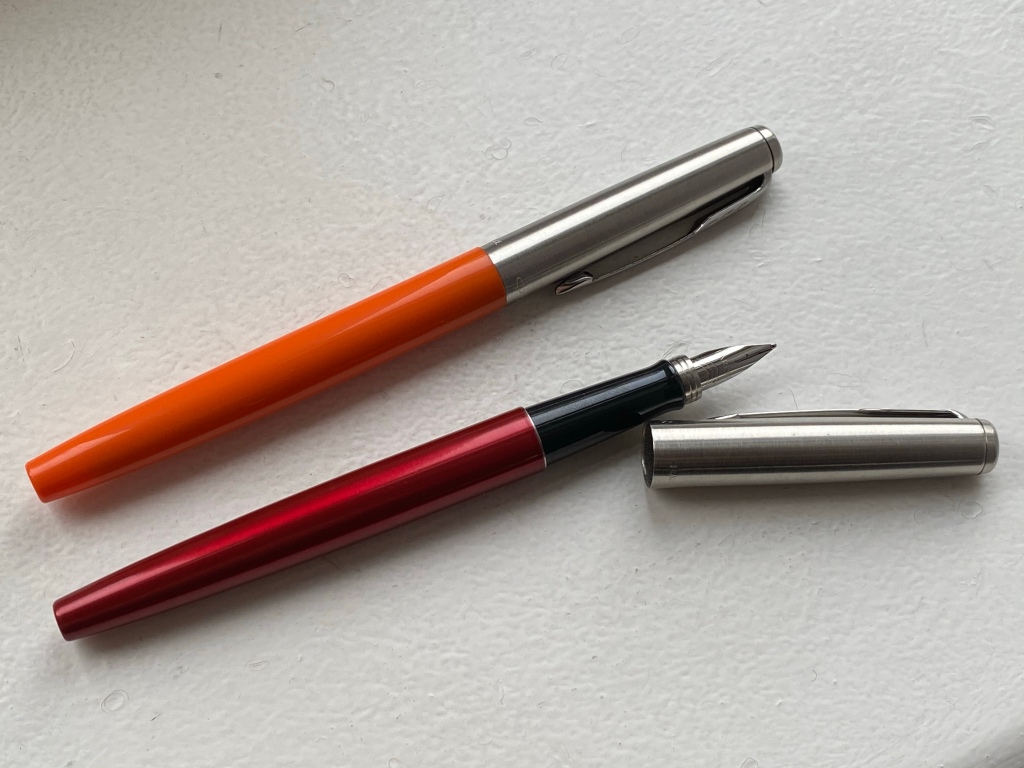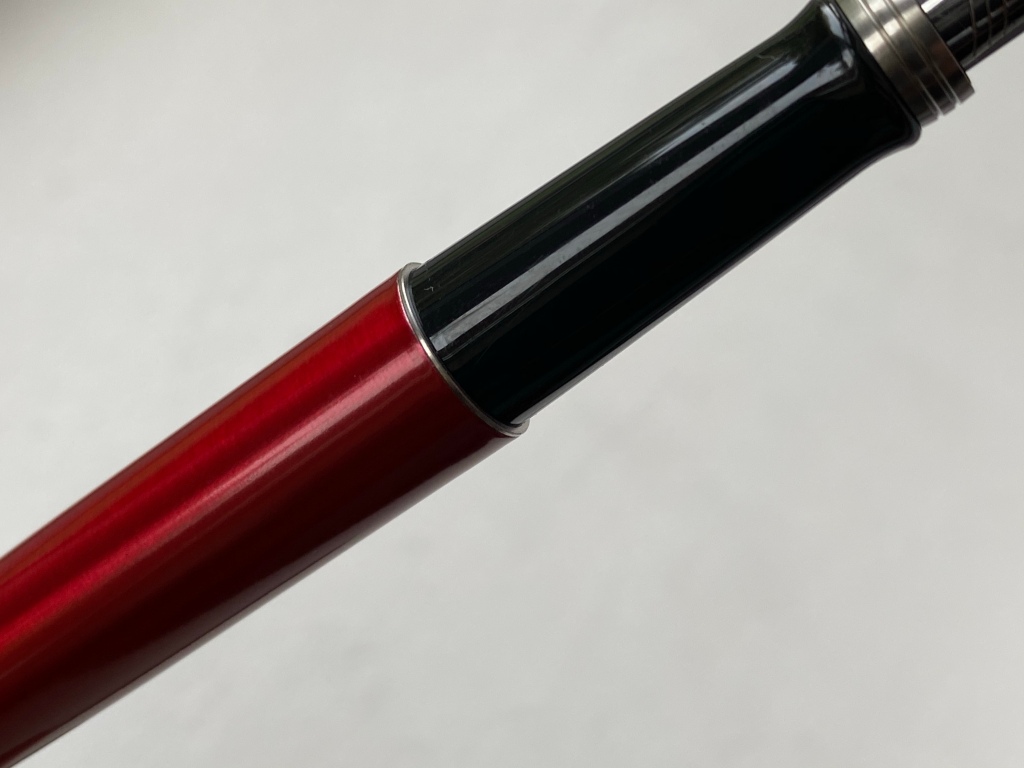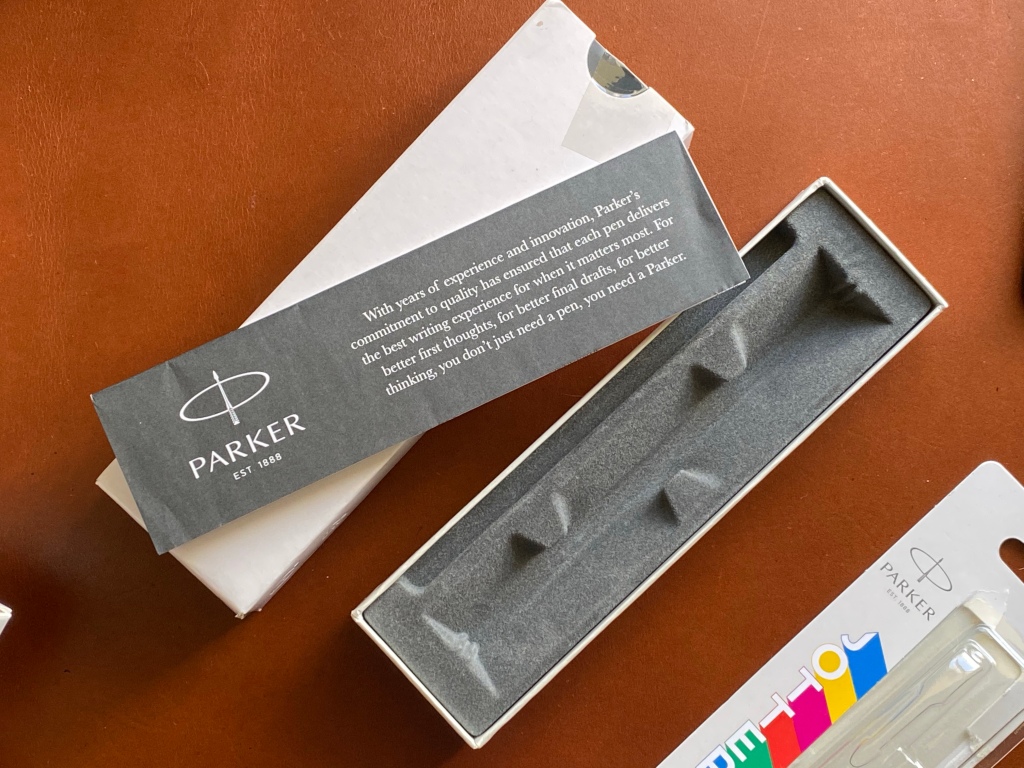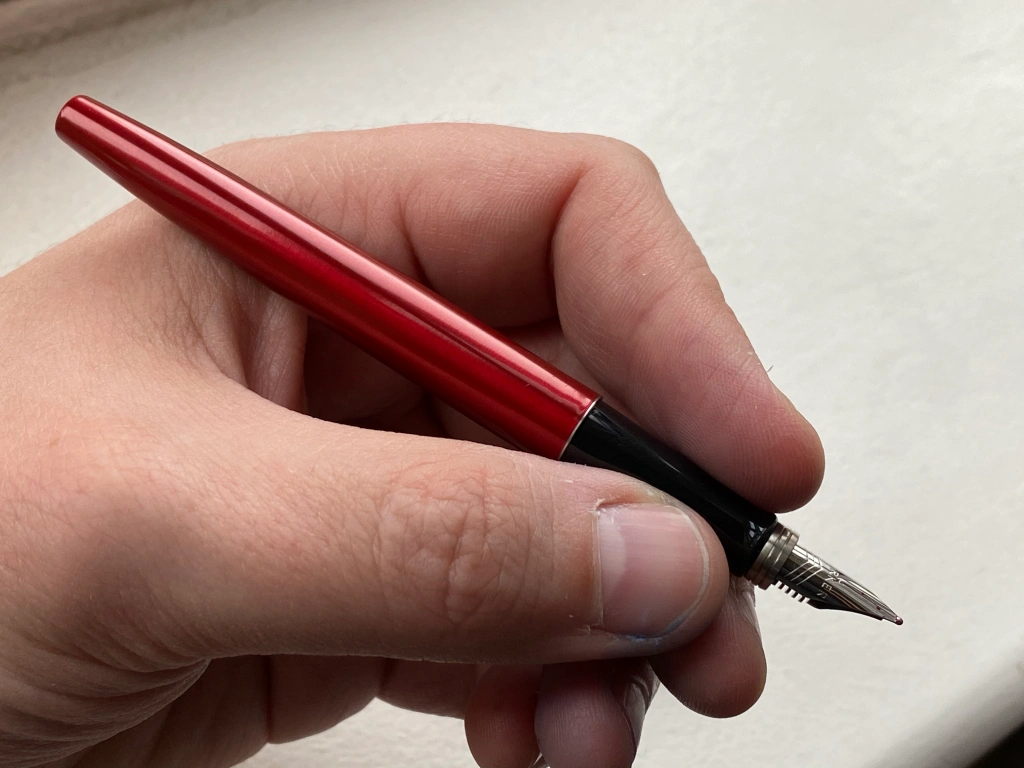Let me be bold and say this: the Parker Jotter is a pretty bad fountain pen.
But before I explain why, let me clarify a couple of starting principles:
- I have deep, fond memories of Parker fountain pens from when I was growing up. As many Brits do, no doubt. Nowadays they may just be a Newell Rubbermaid brand, but I still want them to do well. They still carry the Royal Warrant and, well, Parker shouldn’t do crap pens. I owned Vectors and 25s and 45s and loads of others, and they never let me down, never broke, always wrote well. And the ballpoint Jotter is an awesome little pen, utterly ubiquitous yet a design classic.
- Beginner fountain pens (under £25) are perhaps the most important category of pens. I fiercely believe that these pens should be inspiring enough to make newbies want to buy their second pen. If your first pen is crap, you will go back to your ballpoint. That is a bad thing for the hobby.
So I’ll start with the price, because it’s a defining part of the argument. I bought two Parker Jotter fountain pens from Amazon this week, paying just under £10 for one and just over £10 for the other, on special deals. Nothing about the pens or their packaging suggests that these pens are fake, used returns, or anything else untoward. If you go to Ryman or another high street stationer, you’ll pay up to £25 depending on whether it’s all-stainless, plastic, or some variation.
To me this puts the Jotter in direct competition with the Lamy Safari, Kaweco Sport and Perkeo, TWSBI Go (or even Eco), Platinum Preppy and Prefounte, and dozens of other competent pens from established European and Asian manufacturers, as well as ones like Dryden and Hongdian that are filling up Amazon — and of course the Jinhaos, Wing Sungs and Delikes of this world making varieties of knock-offs from a couple of bucks up.
With this kind of competition, you have to make a good product. And this is where we get to the Jotter itself.

First thing to say: if you’re going to buy a Jotter, do not buy one of the plastic-barrelled ‘Originals’, no matter how much you like one of the colours. The barrel is so thin you can literally squeeze it out of shape with your fingers.

One drop of a schoolbook and that cap will be cracked or in pieces.
It is poorly finished, the barrel lip is sharp, and the blister pack is uninspiring.

The metal-barrelled version I bought, in ‘Kensington Red’, is definitely better feeling in terms of quality (and even weight). The barrel end is better finished for sure.

It comes in a little cardboard box that would be easier to wrap for a kid’s birthday.

But it too is poorly finished.

The cap lip is sharp, the clip edge is rough and lumpy, the PARKER imprinted around the cap edge is faint and uneven.

On both, the threads that attach the barrel to the section are rough and weak-feeling. I don’t know how many cartridge changes they’d survive.

Depending on which version you get, you get either one blue or one blue and one black cartridge in the pack. At this price, a converter is out of the question, but the packaging doesn’t make mention of one as an option either, so newbies will never learn of the joys of ink choices to match their brightly coloured pens.
Inserting the cartridge is mushy and, given how flimsy the pen feels, it’s difficult to know how hard to push to get it fully home.
Both of my pens have steel medium nibs, and they wrote identically, leading me to believe this is how they all come. They look OK, with a visible tine gap, aligned tipping, and no difference in performance before and after flushing with warm water. With the included cartridges, they write dry and somewhat rough, leaving an unsaturated line. They never skipped, hard-started or showed any bad behaviour, though.

The writing experience is noticeably worse than a good rollerball, let alone a good fountain pen. There is no personality to the nibs in terms of bounce or line variation, although perhaps a tiny bit of stubbishness.
I emptied the cartridges and syringe-filled them with Diamine Pelham Blue, a solid performer, and Otto Hutt Rose Red, one of the wettest inks I own. The pens sucked all the life out of them, leaving them faint on the page of Tomoe. So it was the pens at fault, not the ‘school blue’ and ‘black-grey’ Quink cartridges.

I understand that rigid, dry nibs are probably a better choice for bad paper in exercise books and bad writing practice by people brought up on ballpoints, but in this case I feel the dial has been turned just that bit too far.
In the hand, the Jotter is a simply tiny pen.

The barrel is skinny, the section even skinnier, although quite long.

The nib is teensy. The cap posts, but does nothing to improve the comfort at the finger end. Although for people used to skinny ballpoints, I doubt this will be an issue — and of course, entry-level Parkers are often used by kids.
I see some glimmers of positives in the Jotter. The brushed stainless finish on the cap is a robust choice for school bags and pockets. The push-pull cap action has a positive click closed. The modernised arrow clip is a good looker and very springy.

And the almost tubular arrow nib, while tiny and very simply decorated, is pretty.

The overall silhouette is clean and sleek. And each pen is still marked ‘France’, which at least suggests Parker hasn’t booted production to the cheapest bit of China and is instead paying a living wage in a country with labour and environmental standards.

But that’s not enough to make the Jotter a good pen. It just doesn’t feel robust, an essential characteristic for rattling around in handbags and schoolbags. More importantly, it’s a frankly dull and tiring writer no matter what ink you throw at it, which undermines the entire point of going for a fountain pen in the first place. If this had been my first fountain pen, I wouldn’t have bothered buying a second.
This is not my first fountain pen, so I donated both Jotters to my daughter before I could answer my final question about it: does the big hole in the cap make it dry out?

If you’re planning to spend £15 on a fountain pen, get a Kaweco Perkeo with a delightfully bouncy nib, or a Safari with its bulletproof construction and smooth nib. If you were going to spend the Jotter’s full £25, splurge an extra £3 and get a TWSBI Eco, and benefit from proper reusable packaging containing everything you need to service the pen, a piston filler and great nib.
I like Parker. I like the Jotter ballpoint. And I appreciate that I am not Parker’s target market for this pen. It’s not what I’m looking for in a pen under £25. But I’m afraid the Jotter fountain pen is not the beginner pen you’re looking for, either.
I totally agree with your overall sentiments, but there’s one aspect where I diverge…the size of the pen. If we see, or judge, the Jotter as a school pen, then it isn’t necessarily for full grown hands. Also…if we look back at the size of vintage fountain pens…pretty much everyone had to deal with short, narrow pens back in the (hey)day of fountain pens. And pencils. Many children transition (or used to) from pencils. A narrower body of pen to help the grip adjust makes sense for that too. In a way I am making a general point as I often see comments on various sites of pens being too thin or short and then think of the pens I see in trays from vintage sellers. Sometimes I wonder if we forget pen history a little.
Yeah, and I did make the point that a slim grip would be good for kids and ballpoint users coming to a fountain pen for the first time. But it’s a fair observation about vintage pens. I have a Geha that is just dinky, and that was a normal schoolpen. Much like wristwatches, modern pens are larger than their vintage cousins, despite human anatomy being exactly the same…
Yes, you definitely made the point about kids – I flogged it to death a bit because of thinking about pencils Sorry! And to be fair, given that I read of people with arthritis who are glad of fatter pens, I imagine that narrow pens or quills would have been pretty tough.
Indeed, all those poor scribes in cold monasteries must have developed terrible cramp, on reflection! The reason I didn’t hang on the kids thing too much was that I see a lot of Parker Jotters in the workplace, so I expect it to be a natural first FP for young professionals who remember Parker from school, look at the Jotter ballpoint on their desk and put 2+2 together. So I was thinking of adults as much as kids when I judged the comfort.
I spend more time than I should do being grateful that I am not a scribe in a cold stony monastery! I am also somewhat envious that you are seeing fountain pens in the workplace. In my case it is pretty much me and one other person – though the family of one good friend are fanatics which is lovely and a steady supply of inks and cheaper pens may possibly have flowed in that direction… 🙂
Next time I will give a fountain pen to a promising newbie it will be a Faber Castell Hexo, incredible for the price.
Fair comment. I bought a Parker Jotter fountain pen and found it disappointing. It was only inked once. I was far happier with the Parker Reflex although that was not without faults as the cap rim can crack.
The Faber-Castell Grip is a good alternative and costs around £15.00.
It’s a shame, because Parker has decades of experience and the scale to do this really well.
I agree with your points. I love the Parker brand. I have tried the diverse range Parker has to offer, from the simplest Vector up to the Sonnet. I must say that the Jotter fountain pens I have had (one in Royal blue stainless steel and the other in the older SS version) were quite disappointing. Were it not for the logo imprinted around the cap of the Jotter (which was faint as well) and the trademark arrow clip, I never would have thought that the Jotter fp I’ve had came from a ‘once’ reputable company. I was never able to reconcile my expectation of an entry level Parker pen with the actual experience I’ve had with Jotter that I ended up selling my Jotter fps and was quite surprised that they got sold!
There’s one thing I find weird about this review (and a few others that expressed a similar statement) – these Jotters’ nibs were criticized for a lack of personality. I’d like to ask, is lacking personality really that bad of a quality for a nib to have? I’d like to make an analogy with cars – there are tons of boring cars at the low price point; would it really be fair to criticize a car that does its job well for not being exciting (which were the actual criticisms I’ve seen people making towards these sorts of cars)? A pen’s main job is to write, and write reliably; if a pen has no issues with that, I’d say its nib is at least decent, even more so if the pen performs well on “bad” types of paper (I’m not into buying specific types of paper for pens to write on personally, and I believe that shouldn’t even be a concern at the low price range). I believe nibs as dry as Jotter’s would be a nice fit for left-handed people, reducing the risk of smearing for them. Also, based on my own observations of Parker’s tubular nibs (I have a Parker Esprit and a Parker Beta, both of them use this type of a nib), these seem to be able to withstand a considerable amount of pressure without physically deforming, which I believe would make pens with these nibs a good choice for longtime ballpoint pens users, who might have a hard time shaking the habit of pressing on the pen while writing. Sure, I would also love my Parkers to write more vibrantly (as they also have the same issue of writing with a noticeable hint of bleakness, just like Jotters you have reviewed), but I’m more than willing to forgive them that for the qualities I’ve talked about. And I would certainly take versatility and reliability over springiness and line variation. Perhaps I just prefer workhorse types of pens over the ones aimed for enthusiasts.
On an unrelated note, it truly is shameful that the plastic Jotter’s body can be so easily deformed. Parker Beta fares much better in that regard – I could not deform its body with my hand at all. Surprising for a pen with a cheap-as-dirt retail price made in India.
Better off picking up a second hand Parker 45. Easy to pick up a pen with a gold nib off eBay for under £20 with a little patience.
That’s one way to do it — but for a beginner, buying vintage pens on eBay can be a scary prospect, and one dodgy used pen can be enough to put them off fountain pens for life.
I have 2 old Jotters in my collection, which are unused now. I found both were drying out after just a couple of days, yet a cheap Chinese Wing Sung 3008 TWSBI ripoff I purchased to chuck in a bag works every time, even after a couple of weeks. I bought 4 for £17.00 online. For a few quid each, they are marvelous, with only 1 having a scratchy nib which was easily sorted.
I also bought a couple of Jotter ballpoints last year. What a disappointment. They are nothing like the quality of the old Jotters, or Parker as a whole. They feel cheap, unfinished, have sharp edges between top and barrel, feint stamping of the “Parker” name, and worst of all, that clip that used to be solid metal is now a shaped piece of thin metal, nothing like the old ones. Cost cutting all round. I’d have sent them back but had had them engraved. The mighty really have fallen.
I was after a new fountain pen for work. I’m a Structural Engineer and do a lot of sketching where two different line-weights (a heavy one and a light one) are a really useful tool. I like refilling pens rather than discarding them, and have moved away from mechanical pencils. It had to be cheap so that when I lost it or sat on it in my back pocket and snapped it (both pretty standard ways of parting company with favourite pens over the years), I wouldn’t be too upset.
I read your review of the Jotter and was appalled to read that the look-alike replacement for my first and favourite pen (Parker 15) was such a downgrade. So after looking around a bit, and with your recommendations ringing in my head, I bought a Lamy. I was in the shop and had both the ABC and the Safari in my hand – I compared both the nibs and found them to be functionally identical (to my non-expert eye and hand, at any rate), and went for the ABC. I was swayed by the labelling space where I can put my email address should I leave it on the train, the timber body, bold colour (I went for blue), and the fact I wasn’t committing too much money to what was after all an experiment.
Having used the Lamy for a few months, I found it essentially useless, and had to just go and buy a Parker Jotter to see for myself. I was glad I did, so here I will explain why I prefer the Jotter, but do understand why you might be a little disparaging of it, and more favouring of a Lamy style pen.
The difference is all about how a heavy lines and fine lines are produced. As I said above I am a professional Engineer, and my need for different line weights is completely binary. I need a thick one and a thin one, and the Parker does this simple job consistently well. With the nib orientated conventionally it gives a nice medium (lets call it “heavy” for my purposes of sketching) line. You get a bit of variation with pressure, but very little compared to the Lamy- its pretty consistent regardless of what mood you’re in. Flip the nib round and use the back and you get a perfect fine line. The ink flows beautifully and doesn’t run dry. I used my old Parker 15s in this way for years and they suffered no damage at all.
This little trick is probably anathema to a fountain pen collector, but instead true consistency either way up is exactly what was missing in the Lamy. You can get a full spectrum of line weights from the Lamy by varying the pressure (is this the “personality” of the nib?) – and it does do this very well indeed as the nib is really quite bouncy – but turn it over for a consistently thin line (i.e. the same thickness as the last thin line you drew), and the ink runs dry. If I had an afternoon off work to sketch an apple sat next to a jug, with a range of different line weights, I imagine the Lamy might be a better choice, but to quickly and confidently and consistently bang down centre-lines, section marks, dimension arrows, leaders and heavy outlines, and then take down meeting notes as the discussion is happening (not in a coffee shop reverie after the event) the Parker is the tool for the job. As I said, in that context I found the Lamy to by functionally useless. As noted by a previous reviewer – the Parker is a workhorse, and at just the right price point to be so. I love it, and wont be experimenting with springy nibs again any time soon.
I have and still use the plastic black Jotter from 2008, made in UK.
I also have new silver (metal). The nibs are medium but are different. The old one was a bit smoother. I grinded it to Fine myself. It never skipped or hard started. But it is a dry nib. I like it that way because it allows me to write on cheap papers. The new on is more wet and not as smooth as the old one. But still a good performer. The thing is, that old plastic from 2008 is stiff and solid, nothing you can squeeze with fingers. The threads toward the section are finely made, with precision. It looks cheep but nothing like you described above on that orange pen. Overall I can not justify the price I paid for the new silver Parker Jotter. For lower price I got silver Pilot Metropolitan, which is much more complete fountain pen than the Jotter.
Totally Agree!
I recently moved to another country and only took my Pelikans with me (M1000, M800 and M600). I didn’t use any FPs for two years then decided to start using them again at work. After 1 month of using my Pelikans I decided to get this Jotter to use as a workhorse and keep my expensive pens at home. It was a huge disappointment. It is like a pencil!
It is very good on cheap printer paper but on my Rhodia, it is very bad.
I am sorry to have to say that I agree with all of these criticisms and have a few additional ones of my own. Perhaps the worst feature of the latest incarnation of the Parker Jotter fountain pen is the pocket clip, which like the pocket clip on the previous model of Jotter fountain pen has damaged the cloth on more than one of my shirts. The cap on the older, UK-made model of Jotter FP could be replaced with a cap from a vintage Parker 45, solving the problems of the clips snagging some types of fabrics and of just how ugly the UK-made Jotter FP caps were, the clip being held in place by a flat disc of black plastic crammed into a hole atop the cap. I was hoping that the clip would be much improved on these newer Jotter fountain pens from France, but they are about the same, and the Parker 41 caps simply will not fit. The only real improvement is that the ugly black plastic disc has been replaced with a button-like stainless steel cap finial with a somewhat attractive although faint circular-brushed finish. I do enjoy writing with the little guy occasionally, but have experienced flow and consistency problems similar to those that the review decries if I use my favorite inks. The ink that works well in it, at least for me, is Namiki Blue — the variety sold in the inexplicably flat and shallow 60 ml bottle under UPC no. 72838-69201. This ink also works well as a so-called “infinity ink” that solves the problem of feeds that dry out even with the cap securely closed, although Pilot-Namiki doesn’t market it as an infinity product. The reviewer writes that he didn’t keep the pen long enough to find out if it dries out even properly capped, but unfortunately, I can report that with most ordinary inks, it does. Finally, while I agree that one would do well to go with the metallic barrel version rather than the flimsy plastic ones, I don’t trust the finishes of the colored ones to hold up. I have heard nothing about whether these colors are anodized finishes, enamel, lacquer, or what. I therefore purchased the version with a brushed stainless steel finish on both cap and barrel. I am pleased enough with it at the US$9 price that I paid for it brand new, postage included, as I don’t find the nib to be scratchy. Still, I believe those who say theirs are scratchy. Maybe I lucked out, or maybe Parker has improved the nibs since early production. I don’t believe I would have paid the list price for a pen that I suspected I wouldn’t dare carry in my pocket, however, and it turns out that half expecting it would have a fabric-snagging clip was a realistic concern. Parker simply is no longer the same company. Products from their French factories used to be full-value Parkers, sometimes with handcrafted nibs and engine-turned barleycorn or Clou de Paris finishes on sterling silver caps and barrels, but in recent years, things have changed. Since the closure of their UK and American factories, enough of my ballpoints have been slimed by leaking French-made Parker ballpoint and especially rollerball cartridges that I no longer buy Parker cartridges, and use German equivalents or hermetically sealed Fischer Space Pen cartridges instead. This was never even once a problem for me when the genuine Parker cartridges were made in the US and England — and I’d been using them since I learned how to write at the age of 6. It would appear that quality control is a non-issue for the new Parker’s current Rubbermaid-Newell lords and masters, and anyone who harbors a low opinion of the company is right to do so.